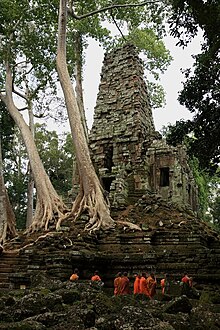Preah Pallilay was built by the king of Jayavarman VII last 12th century dedicated to Buddha. Preah Pallilay is a meeting place of the believer monks and nuns and Preah Pallilay has 4 entries and Preah Pallilay is a pyramid temple and has the shape as chimneys full of stone.
The coexistence of hindu and buddhist elements and lacking of foundation stele or inscriptions make somewhat difficult dating this temple. It is generally ascribed to Jayavarman VIII reign, but it seems difficult to explain how the buddhist imageries could have survive from the iconoclast fury of that epoch. Maybe it was built in different periods: the sanctuary in the first half of 12th century, while the gopura in the late 13th or early 14th century. The temple was cleaned by Henri Marchal in 1918-19, while the gopura was restored by anastylosis by Maurice Glaize in 1937-38
Description
The temple has a cross-shaped terrace, 8.5 m by 30 m long, with seven-headed nāga balaustrades in good conditions, on the east, guarded by two decapitated dvarapalas dvarapalas and a lion (of an original two). A 33 m-long causeway connects it to the single sandstone gopura.[2] Before the laterite enclosure 50 m square there is a shrine with a 3 m tall statue of Buddha, sitting on a lotus, of a later period.
The gopura has three entrances, the east-facing pediment of the northern one shows "the offering of the animals in the forest of Parilyyaka", where the Buddha retreated after leaving Kosambi. It seems that the origin of Pralilay could have been the alteration of the name Parilyyaka.[3] Even the other pediments shows exemplary scenes of Buddha.
The sandstone sanctuary stands on a three tiered basement, 6 m high in overall. It has a 5 m square central chamber that opens to the four cardinal points with as many vestibules. Their classical ornamentations, unfortunately ruined, suggest that the sanctuary belongs to the first half of the 12th century and is older than the gopura. Even the characteristic "chimney-like" tower that stands above seems to be a later addition, maybe a frame for a covering.
Some parts of the pediments have been taken away for safe-keeping, others lying on the ground. The visibile parts show Indra on his mount, the elephant Airavata, and the assault of the demoniac army of Mara.[4]
At the present time there is a little buddhist monastery near the temple and the presence of the monks in its area is not uncommon.


0 comments:
Post a Comment